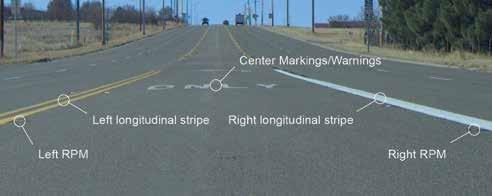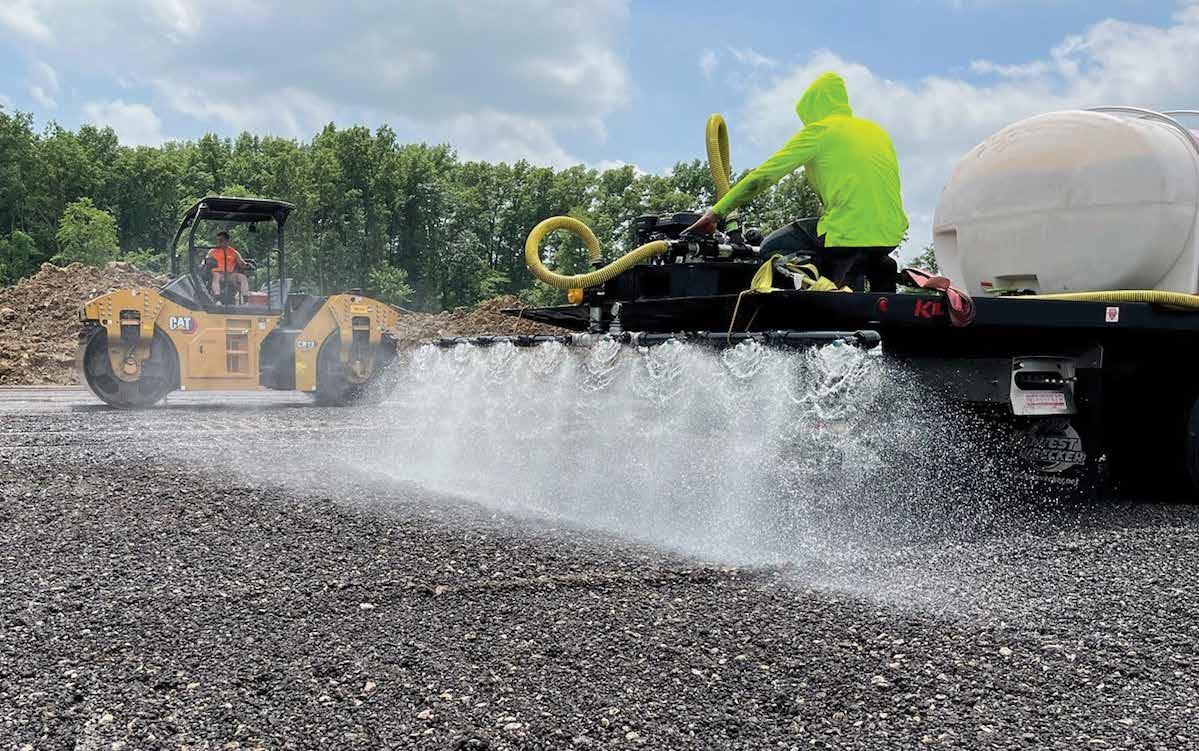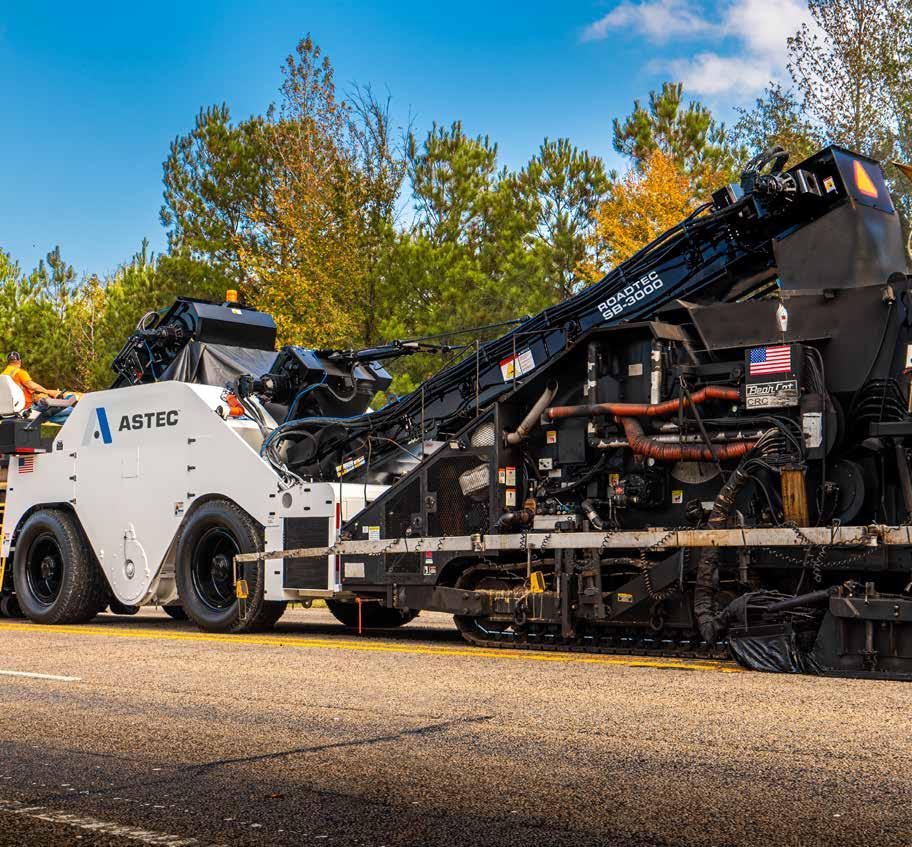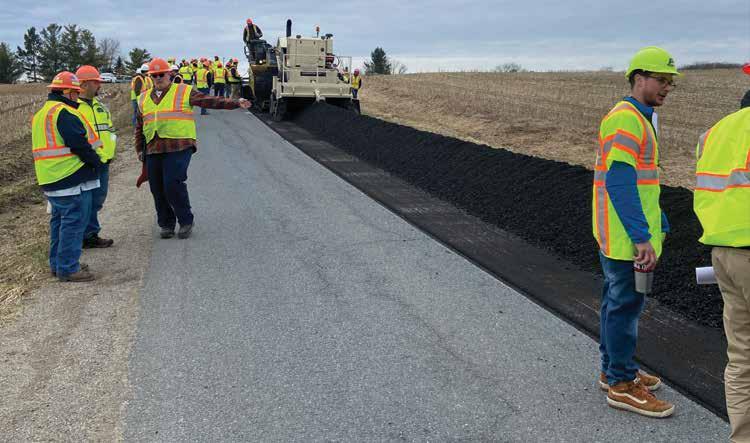
10 minute read
How to Pave Fibreless SMA
After Lindy Paving milled 1.5 inches from State Route 376, its paving crew came in to pave 1.5 inches of stone matrix asphalt (SMA) with fibers and without fibers the weekend of Sept. 17-18. They not only achieved on-spec densities for the Pennsylvania Department of Transportation, but they also offered a successful pilot project of fibreless SMA for the agency. Photo courtesy of Ingevity
A Lindy Paving and PennDOT mill-n-fill pilot trials warm-mix options for stone matrix asphalt without fiber
BY SANDY LENDER
TTo offer contractors options when building stone matrix asphalt (SMA) pavement systems in the state, the Pennsylvania Department of Transportation (PennDOT) let a 3.9-mile mill-and-fill project on Business State Route 376 (SR376) in Allegheny County as a pilot project. The option was to design the mix without fibers and the team from Lindy Paving Inc., New Galilee, not only took on the challenge, but also lowered fuel consumption via lowered production temperatures while enhancing performance test results.
Plant Quality Control Manager Martin Libertini, who has been with Lindy Paving for seven years, said the company’s Neville Island plant is set up to introduce fibers or other additives into mixes during production, but the concept of making a fibreless SMA for the state also gave them the opportunity to inject innovation. And that’s something the team at Lindy Paving is known for.
Pennsylvania Asphalt Pavement Association (PAPA) Executive Director Charles C. Goodhart reminded us that Lindy Paving has been awarded five National Asphalt Pavement Association Sheldon G. Hayes awards for highest quality paving projects.
“Without a doubt, Lindy Paving is one of the premiere asphalt mix producers and laydown contractors in the United States,”
Goodhart said. “Lindy leads the way with quality and innovation because their president, Vince Tutino, sets the example of pushing forward to ever improve their operations and organization.
Lindy focuses on the customer and encourages innovation and risk-taking from their staff. If you want to move the state of the possible forward, get Lindy Paving involved and they will make it happen.” The state of the possible in this case was, as Libertini shared, to modify the state’s spec to allow contractors the option to use fibers when placing an SMA pavement. The end user benefits when industry is allowed to innovate and make choices concerning the right materials and right methods on the right road at the right time. The industry partners who came together to develop the pilot project workplan for assessing this innovative idea were
PennDOT, PAPA, Lindy Paving, and Ingevity Pavement Technologies, headquartered in North Charleston, South Carolina. “One of the roles of the PAPA is to bring innovations in asphalt pavement technology to the highway owners for their consideration,” Goodhart shared. “If we don’t try it, they won’t buy it. So, a pilot project is normally necessary to prove that a material, additive, technology, equipment, test, etc. works as well as or better than the product it is replacing. This project, completed by Lindy Paving, with technical assistance by Ingevity, proves that you can produce SMA without the use of fibers.”
Let’s start by looking at the mix design options on the table.
MAKE THE MIX
Libertini said, “The key to making the fibreless SMA work is to go with a true warm-mix asphalt so you’re producing at cooler temperatures. You want to produce it around 280 degrees instead of 320 to 330 degrees, where you’d normally run that material.”
Making the fibreless SMA as a WMA offers the obvious benefit of lowering fuel consumption, thus lowering emissions, but it also offered the Lindy Paving team an opportunity to reduce the traditional 6.7% liquid asphalt cement (AC) content of an SMA by 0.3%, thus lowering production costs. The WMA paradigm also saw positive index testing results, according to Libertini. “We’re saving on cost a little bit, but we’re gaining performance,” he said. “It was amazing how much better the testing got.”
He explained, “We performed Index testing in 2021 using three different labs. We performed testing at our Zelienople Central Lab and Ingevity ran samples at their lab and Rutgers University. The IDEAL-CT Index test for cracking resistance is where we saw the increased performance on the fibreless SMA.”
As he explained, the traditional SMA contains cellulose fibers that exist in an incredibly fine, almost dust-like state. “The fibers are used to make the liquid binder stable,” Libertini said. “Traditional SMA uses cellulose fibers to prevent the liquid asphalt binder from draining out of the mixture. You have to use warmmix technology, producing the mix between 260 to 285 to prevent drain down.”
When the team removed the cellulose fiber content from the equation, it was necessary to counteract the potential for drain down. They raised the film thickness of the liquid with warm-mix temperatures, facilitated by the use of Evotherm J1 from Ingevity.
“We wanted to establish limits for drain down, so we ran tests from 275 to 295 with 295 being our limit,” Libertini said. “However, we produced this mix and never exceeded 285 and our average temperatures were between 275 and 280.”
Let’s look at the production for the Sept. 17-18, 2022, pilot project.
Table 1. Test Results from 2021 and 2019
MIX TYPE ESAL
PG GRADE Test DATE Lab or Plant MIXED MACHINE Settings
TEMP
SET (BOTH) Before
Virgin 9.5 mm Fiberless SMA 3<30 76-22 06/29/21 Lab mix 50C 158
SIDE AVG VOIDS
L 7.0
R 7.1
Number of passes at Max Impression
Max Impression
20,430 8.941
Virgin 9.5 mm Fiberless SMA 3<30 76-22 06/03/21
9.5mm SMA w/Fiber 3<30 76-22 03/27/19 Lab mix 50C 158
Lab mix 50C 158
Virgin 9.5 mm Fiberless SMA 3<30 76-22 07/15/21 Lab mix 50C 158 L 6.8
R 6.8
L 7.0
R 6.9
L 6.8
R 6.8 20,900 9.2
20,412 4.733
20,520 6.026
Passes Left Side Right Side
20,430 8.941
20,484 8.183
20,986 9.220
20,990 8.040
20,412 4.733
20,360 3.562
20,520 6.026
20,492 5.598
Creep Slope Strip Slope Stripping inflection Point IDEAL - CT Index Testing Lab
NONE NONE NONE 1623.5 LCL
NONE NONE NONE 1343.5
NONE NONE NONE 1156.5
NONE NONE NONE 1534 Ingevity
LCL
Ingevity


Along with measuring and monitoring temperatures, testing was a significant portion of the pilot project. In the photo at top, Nathanael Hook performs the drain down testing in the lab. Both photos courtesy of Lindy Paving
PRODUCE IT AT THE PLANT
The traditional SMA and two fibreless mixes—one using the additive Sonnegreenas by Sonneborn LLC at a 0.25% dosage rate and one using the additive Evotherm J1 at a dosage rate of 0.5%—were produced at the Neville Island Gencor 600-ton-per-hour drum plant.
Lindy Paving produced the traditional SMA on Saturday and paved the fibreless SMA on Sunday. With a target temperature in the 320-degree range, the plant hit a production between 350 and 400 TPH, according to Barilla. He shared that the natural gas consumption on Saturday/with the traditional SMA was 60 MCF/hour, taking readings every 10 minutes for an hour.
Libertini confirmed his team injected the Evotherm J1 into the asphalt cement at the plant, adding it at a rate of half a percent. Sunday’s production of fibreless SMA mix was between 300 and 350 TPH and the natural gas consumption showed 45 MCF/hour, taking readings every 10 minutes for an hour.
Let’s look at how these mixes arrived and performed in the field.
PAVE IT IN THE FIELD
The job began with the cold planing portion of the mill-n-fill. Lindy Paving’s crew handled milling operations, using two Wirtgen 210 cold planers and a Wirtgen 150 cold planer to remove 1.5 inches of existing pavement. Greg Tomon, the field quality control manager for Lindy Paving, has been with the company for 22 years, and shared how the milling crew adapted to a quick challenge on the roadway.
“After milling 1.5 inches off concrete, some areas began to ravel. We took the mill back out and took the remaining asphalt down to concrete in a few areas in the passing lane.”
They paved the 9.5-mm SMA at a width of 13 feet and at a depth of 1.5 inches, using a CAT AP1055D tracked paver with an ExtendA-Mat 10-20B screed. A Shuttle Buggy SB2500 from Astec Industries took delivery from the haul trucks at consistent temperatures.
The temperatures ranged from 245 to 265 at the paver for the fibreless SMA, according to Libertini and Tomon. They observed temperatures, “Cooler than we normally would see from fibered SMA with little to no problem being fed through the MTV/paver.”
Five rollers made up the compaction train. Tomon listed the Sakai SW774 in the breakdown position. Barilla listed the other rollers as the SW800, two SW770HF compactors, and a tandem Hamm compactor “for rolling against the curb and barrier wall.”
For the fibreless mix, the compactors averaged 94.8% density, according to Libertini and Tomon. They observed, “The mat did move around more than fibered SMA,” but “It stayed workable all the way down to 120 degrees.”


The team monitored temperatures in the back of the haul truck at delivery and at the paver. Both photos courtesy of Lindy Paving
Let’s grow the future of asphalt.


At Colorbiotics, our soybean-based science is changing the asphalt industry just as much as it changes the molecules inside recycled asphalt. But having the best science in the business only makes a difference if we have the best people, too.
We are looking for sales people to join our team — so let’s talk about your future and get to growing together.
Give us a call: 888-663-6980 | Apply today: invigorateasphalt.com

The compaction train comprised a Sakaii SW774 in the breakdown position, with an SW800 and two SW770HF compactors behind it, and a tandem Hamm compactor handling work against the curb and barrier wall. Photo courtesy of Ingevity
They used the same compaction train for the traditional SMA, which they said saw temperatures between 290-305 degrees at the paver and achieved an average density of 95.8%.
PROVE IT
With PennDOT districts continuing to use more 9.5-mm and 12.5mm SMA mix designs on interstates and other high traffic volume roadways, giving contractors options to enhance the designs’ performance is in the agency’s best interest. As Libertini said, “If we can lay down mix at cooler temperatures and still get good performance, that’s a good end result. It’s lowering emissions and getting performance. It’s all good for the state.”
Barilla shared that the team took eight 5-gallon samples of mix during production Saturday and another eight 5-gallon samples during production Sunday. These samples have gone to Ingevity’s lab for volumetric and balance mix design testing as well as binder aging assessment. Those results, along with highlights learned from the weekend’s project, will be shared at the 63rd Annual PAPA Conference in Hershey, Jan. 16-18, 2023.
“Again, our members are always open to trying new products,” Goodhart said. “Doing demonstration projects such as this shows not only the ways and means of how you can make a fibreless SMA, but also what the ancillary benefit will be, like lower carbon footprint, reduced asphalt mix costs, etc. We plan to have Lindy and Ingevity make a presentation at our annual conference to preview the pilot project and highlight the production, delivery, laydown, and testing required for the pilot. We think PennDOT will see the viability of allowing fibreless SMA and we intend to suggest that we change the specification to allow producers to supply either fibreless or SMA with fibers. A permissive spec would seem like the way to go for now.”

The Shuttle Buggy fed the mix to the paver’s hopper insert, to allow a consistent flow, head of material, temperature, and homogenized mix. Photo courtesy of Ingevity
LEARN MORE

WMA in SMA
The team from Ingevity shared, “Using a lowtemperature warm-mix asphalt (WMA) additive like Evotherm is a proven way to eliminate drain down without the use of fibers” in a stone matrix asphalt (SMA) mix. “Almost 2 million mix tons of fibreless SMA with Evotherm have been paved across the United States. Three hallmark benefits of these mixtures are improved drain down, remarkable cost savings, and increased density and workability,” according to the manufacturer.











